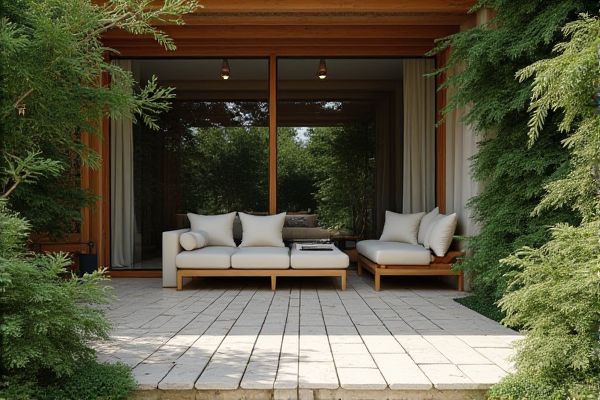
Espalier involves training trees or shrubs to grow flat against a surface or support, creating decorative and space-saving patterns, while topiary focuses on sculpting plants into ornamental shapes through precise pruning. Discover how your garden can benefit from these distinct horticultural techniques by exploring the detailed differences in the rest of the article.
Table of Comparison
| Feature | Espalier | Topiary |
|---|---|---|
| Definition | Training plants along a flat framework or wall | Shaping plants into ornamental forms through pruning |
| Purpose | Space-saving, increased fruit production, decorative | Decorative, artistic garden elements |
| Common Plant Types | Fruit trees (apple, pear), vines | Boxwood, holly, yew, privet |
| Training Method | Tied and pruned along a support structure | Regular shaping by precision pruning |
| Maintenance | Moderate pruning and guidance yearly | Frequent trimming to maintain shape |
| Visual Effect | Flat, geometric patterns on surfaces | Three-dimensional shapes and sculptural forms |
| Best Use | Walls, fences, small gardens | Hedges, garden paths, focal points |
Understanding Espalier and Topiary
Espalier involves training trees or shrubs to grow flat against a support, maximizing space and enhancing fruit production, while topiary is the art of trimming plants into decorative shapes, focusing on aesthetic appeal. Understanding espalier allows you to optimize garden productivity with structured growth patterns, whereas topiary emphasizes artistic pruning for visual impact. Both techniques require precise pruning skills and regular maintenance to achieve their distinct horticultural goals.
Historical Origins: Espalier vs Topiary
Espalier originated in ancient Rome and gained prominence during the Renaissance as a method to train fruit trees against walls for improved sunlight exposure and space efficiency. Topiary traces back to Roman times as well, evolving through the 16th century in European gardens where sculpted shrub shapes symbolized status and artistic expression. Both techniques illustrate historical horticultural mastery but serve distinct aesthetic and functional garden purposes.
Key Techniques: Training Methods Compared
Espalier involves training plants, particularly fruit trees, to grow flat against a support using tied branches and careful pruning to create symmetrical patterns, optimizing sunlight exposure and space. Topiary focuses on shaping shrubs or trees into decorative forms through rigorous clipping, trimming, and sculpting to develop three-dimensional shapes. Both techniques require regular maintenance, but espalier emphasizes linear growth and fruit production, while topiary prioritizes ornamental aesthetics and sculptural design.
Plant Selection for Espalier and Topiary
Plant selection for espalier typically includes fruit trees such as apple, pear, and cherry, prized for their flexible branches and structured growth patterns. In contrast, topiary favors evergreen shrubs like boxwood, yew, and holly, chosen for their dense foliage and ability to withstand frequent pruning into intricate shapes. Successful espalier and topiary both require species with vigorous growth and resilience to shaping techniques to maintain their distinctive forms.
Design Aesthetics: Structure and Visual Appeal
Espalier showcases a flat, two-dimensional structure by training plants to grow against a support, creating a sleek and architectural visual appeal ideal for formal gardens and space-saving designs. Topiary, in contrast, involves sculpting shrubs or trees into three-dimensional shapes, offering a playful or elegant sculptural element that enhances garden depth and texture. Both techniques emphasize precision and artistic pruning, but espalier highlights linear patterns while topiary emphasizes volumetric form.
Maintenance Requirements: Pruning and Care
Espalier requires regular, precise pruning to maintain its flat, two-dimensional growth pattern against a support, which encourages fruit production and airflow. Topiary demands frequent trimming to preserve its intricate shapes and sculptural forms, often involving detailed and artistic care. Both techniques need consistent monitoring for pests and diseases, but espalier typically involves more strategic branch training and seasonal cuts for fruiting.
Space Optimization: Urban vs Garden Applications
Espalier is ideal for urban spaces due to its flat growth against walls, maximizing limited areas without sacrificing greenery, while topiary suits larger garden settings where sculptural plant forms can thrive in open spaces. Espalier's vertical training optimizes narrow fences or patios, making it practical for small city yards and balconies. Your choice depends on spatial constraints: espalier for tight urban environments, topiary for expansive garden artistry.
Benefits for Gardens and Landscapes
Espalier and topiary offer unique benefits for gardens and landscapes by maximizing space and enhancing aesthetic appeal. Espalier shapes trees or shrubs against walls or fences, improving sunlight exposure and air circulation while providing a living privacy screen. Topiary adds artistic, sculptural elements that can define pathways and focal points, making your outdoor space visually striking and organized.
Challenges and Common Mistakes
Espalier requires precise pruning and training to maintain its flat, two-dimensional growth habit, with common mistakes including over-pruning that stunts fruit production or under-pruning that leads to tangled branches. Topiary involves sculpting shrubs into defined shapes, where challenges include uneven growth and damage from harsh cuts, often resulting in failed symmetry or plant stress. Both techniques demand regular maintenance and patience, as improper timing or tools can compromise plant health and design quality.
Choosing Between Espalier and Topiary: Which is Best for You?
Choosing between espalier and topiary depends on your garden space and design goals; espalier is ideal for maximizing wall space and producing fruit, while topiary offers sculptural shapes for decorative appeal. Espalier trains plants flat against a support, perfect for narrow areas, whereas topiary involves pruning shrubs into geometric or whimsical forms for visual interest. Your decision should consider maintenance time, plant species, and the desired impact on your landscape's aesthetics.
 homyna.com
homyna.com